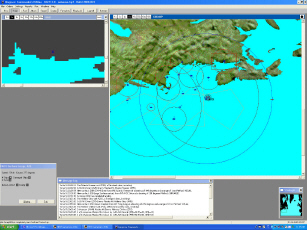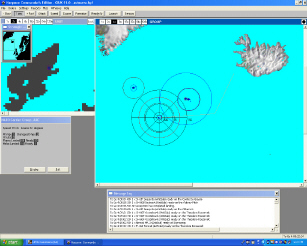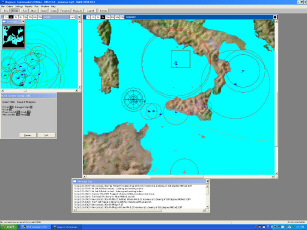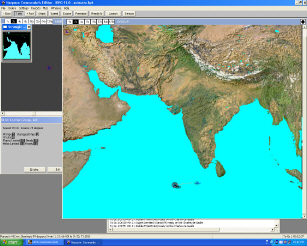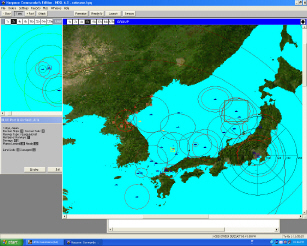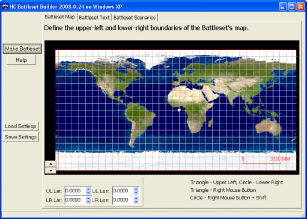|
|
||||||||
THAT CLASSIC, AGAIN MODERN NAVAL WARFARE WITH LARRY BOND'S HARPOON - COMMANDER'S EDITION
When I bought my first DOS-based PC almost twenty years ago, it was a very happy day, one that actually changed my life. Work was never the same, neither was play, and I discovered a whole new universe of technology. Later would come online communications and the Internet. Soon though I had one major regret: My new computer could not handle the one game that I really wanted to play, Harpoon. In those days not every box had a hard drive inside, and the the first DOS version of the game was a little too big to fit on a 360 megabyte floppy or even, like my first computer game M1 Tank Platoon (Microprose), two of them. Until I spent three hundred dollars on a massive forty megabyte hard drive, I was out of luck. About a year later I finally got that drive, a used one, from my brother-in-law, who threw in a copy of WordPerfect 5.1 as a bonus. Then the next thing I did was go to a local Electronics Boutique and pick up the original Harpoon, published back then by Three-Sixty Pacific. It soon replaced M1 Tank Platoon as the most played "real" wargame on my PC. That is easy to believe now. Much more surprising is that I still playing what amounts to the same game. Not a second or third generation redesign or reimagining of Harpoon, but what amounts to the same game. It is vastly expanded, has improved graphics, and evolved onto the Windows platform, but it is the same game. Justly called Harpoon "Classic," that line of evolution's definitive version was Harpoon Classic 97, published by Interactive Magic. It incorporated all the battlesets of the previous versions, which started life as separately-purchased expansions, and added much-improved graphics, specifically in the maps. There was a second line of evolution for the Harpoon series, starting with Harpoon 2, again by Three-Sixty Pacific. It was intended to be a more sophisticated, true simulation, and it largely succeeded. The commercial success did not match though, and to some extent neither did intuitive fun factor. For about ten years the state of Harpoon remained frozen in place. After Three-Sixty Pacific and then Interactive Magic passed from the scene, a procession of publishers attempted to resurrect the series, but nothing came of any of it. Matrix Games finally succeeded though, and did so twice. First the company published an updated, Windows update of Harpoon 2 titled Harpoon 3: Advanced Naval Warfare, which proved to be an excellent addition to the series. Then came the product that the gaming community had really awaited. The full title is Larry Bond's Harpoon - Commander's Edition. It is misleading for one major reason; it really should contain the word "Classic," because that is exactly what it is. On the surface, Harpoon - Commander's Edition is Harpoon Classic 97 with a new name. It uses almost all of the same graphics, which is something of a weakness, as what was state of the art in 1997 can be a little rough and crude by the standards of 2007, when the new game was released. The combat animations, holdovers from the days of CGA graphics when everyone got four colors whether they needed them or not, and the water was glaring cyan, are especially ancient-looking. So are the graphics in weapons systems database; some things have not change at all since 1989. Likewise, the music from the older versions remains. Just as the graphics are reminiscent of the CGA era, the musical score is of a standard that used the computer's internal speaker, and has not progressed to the point at which the term "multimedia" takes on any validity. Despite all this, it would be a mistake to judge Harpoon - Commander's Edition harshly, only because the pictures and music are from a bygone era. Just as the game retains what is grindingly retro, it retains everything that makes the entire Harpoon Classic bloodline one of the most enduring in computer gaming history. The interface is identical to that of all the Harpoon Classic games that came before. That is, most assuredly, a good thing, as Harpoon Classic is an unusually intuitive system. Furthermore, anyone experience with past titles will be able to play this one without any transition. Technically, the game is improved over its illustrious predecessors. Harpoon - Commander's Edition professes to work better on operating systems and with graphics cards than earlier iterations. This is the kind of change that players probably will not notice, and are not really supposed to. Other improvements are supposed to be noticed. Submarine combat is modeled better, with boats harder to detect, especially from the aerial platforms. Air combat appears to favor the United States and its allies a lot less, especially if an American/NATO/"Blue" human is less than careful. There are going to be more cases in which the OPFOR side is going to win air battles, something that rings more true than the days when F-14's and F-15's killed everything that dared fly against them. Older versions of Harpoon Classic could exhibit some strange behavior at times. One example comes from one of my favorite scenarios is "The Libyan Bomb" from from Battleset #3 - Extended MEDC (Mediterranean Conflict), in which American, French and Italian carrier groups go after Colonel Ghaddafi's regime. There are some large air battles in this scenario, in earlier Harpoon Classic versions, including Harpoon Classic 97, French carrier planes often flew off to the northeast mapedge for no discernible reason. Repeated tests of the same scenario in Harpoon - Commander's Edition failed to replicate this phenomenon. Just once, a flight of US Air Force F-22's flew to the northeast instead of landing in Sicily as they should have, but it appears to be an isolated incident. Except for the very earliest versions of Harpoon, a scenario editor has been a vital part of the game, and there has been plenty of opportunity for enterprising players to indulge their creativity. Harpoon - Commander's Edition continues the trend and, like earlier Windows versions, one can expect to find a multitude of user-designed scenarios. It then goes further, a lot further. One weakness in the older editions is that writing background orders for scenarios was difficult; line breaks were impossible to insert, and so designers had to put in blank spaces to make the lines break properly. Now, the newest installment of Harpoon comes with a dedicated orders editor that makes this basic task a lot easier. Players can also do more than just edit scenarios. The weapons database is provided in Microsoft Access format, so that platforms can be edited, a very powerful capability. Also, players can design their own custom battlesets, covering almost any part of the world. The "BattleSet Builder" starts with a global map, and the designer marks off where he wishes to set his conflict. There are limits, mainly due to map distortion toward the poles, but otherwise one has an extreme level of freedom regarding the theater of war. Thus single scenarios are just the start. Users now have abilities to expand the game that were once the preserve of the software developers. No matter how I look at it, Harpoon is one of the most amazing games ever published. First, there are its roots as the definitive miniatures rules set for modern naval warfare, and it is still published by Clash of Arms. Then there is the long line of computer games, including the underrated Harpoon 2 and Harpoon 3 bloodline, that persists to this day, retaining their currency, vibrancy and fan loyalty. None of them might have the prettiest graphics in 2008, but they certainly have the gaming value and the legions of players to make up for it. Personally, I am struck by the computer games that took up my hard drive space and time in the first few years when Harpoon for DOS was new: Space: 1889 (Paradox), Wasteland (Electronic Arts), Strike Fleet (Electronic Arts), Conflict: Middle East (SSI), and of course M1 Tank Platoon. All were a great deal of fun for the time, and Conflict: Middle East's conceptual DNA survives through The Operational Art of War III. Despite that, and no matter how enjoyable any of them were when EGA graphics were on the bleeding edge of technology, only Harpoon Classic survives in what is essentially its basic form, with the original look and feel, and unchanged interface, for good or ill. The last really important change to the graphics occurred in 1997, and the last change to essential gameplay occurred... never. When Harpoon for the computer first came out, it was considered an extremely sophisticated simulation, with the computer making it a lot more playable than the miniatures version. Later, standards would change, and developers and part of the Harpoon community wanted a title with an even greater claim to the term simulation; the result would be Harpoon 2, and now Harpoon 3: Advanced Naval Warfare. Both Harpoon 3: Advanced Naval Warfare and Larry Bond's Harpoon: Commander's Edition benefit from what might be called the "Matrix Treatment." As with its other reissues, including The Operational Art of War III, Matrix Games keeps what gives the original games merit and popularity, improves them technically, and then adds features, including scenarios and editing utilities. Harpoon: Commander's Edition is a fine example of the Matrix Treatment at its best. Someday, one hopes, the Matrix Treatment will include will expand to include substantially improved graphics. Harpoon 3: Advanced Naval Warfare could have benefited from them and, to a lesser extent, Harpoon - Commander's Edition. SCREEN CAPTURES |

